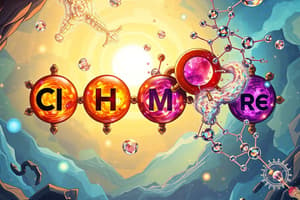Podcast
Questions and Answers
What color indicates the presence of Cu2+?
What color indicates the presence of Cu2+?
Which smell may indicate the presence of CH3COO-?
Which smell may indicate the presence of CH3COO-?
What is noted when sodium carbonate is added to a little salt?
What is noted when sodium carbonate is added to a little salt?
Clear solution
What indicates the presence of Zn2+ during the action of heat?
What indicates the presence of Zn2+ during the action of heat?
Signup and view all the answers
What gas is evolved with the addition of dil. HCl?
What gas is evolved with the addition of dil. HCl?
Signup and view all the answers
What color flame indicates the presence of Ba2+?
What color flame indicates the presence of Ba2+?
Signup and view all the answers
What indicates the presence of Cl- when tested with Conc. H2SO4?
What indicates the presence of Cl- when tested with Conc. H2SO4?
Signup and view all the answers
What is the inference when reddish brown vapors are observed with Conc. H2SO4 and copper turnings?
What is the inference when reddish brown vapors are observed with Conc. H2SO4 and copper turnings?
Signup and view all the answers
The absence of NH4+, Zn2+, CH3COO-, CO32-, and NO3- is indicated by no characteristic change.
The absence of NH4+, Zn2+, CH3COO-, CO32-, and NO3- is indicated by no characteristic change.
Signup and view all the answers
Study Notes
Preliminary Examination of Inorganic Simple Salts
-
Color observations can indicate specific metal ions:
- Blue suggests presence of Cu²⁺
- Pink indicates Mn²⁺
- Colorless implies absence of both Cu²⁺ and Mn²⁺.
-
Smell analysis can reveal potential anions:
- Vinegar smell suggests presence of CH₃COO⁻ or NH₄⁺.
- Ammonia smell is indicative of NH₄⁺.
-
Adding sodium carbonate produces a clear solution confirming presence of NH₄⁺.
-
Heating the salt results in various observations:
- Colorless gas with ammonia smell suggests NH₄⁺ presence.
- Yellow when hot and white when cold indicates Zn²⁺.
- Vinegar smelling vapors and a colorless gas turning lime water milky imply presence of CH₃COO⁻ and CO₃²⁻, respectively.
- Reddish-brown vapors suggest NO₃⁻ presence.
- No notable reactions mean absence of NH₄⁺, Zn²⁺, CH₃COO⁻, CO₃²⁻, and NO₃⁻.
-
Flame tests can identify specific cations:
- Pale green flame suggests Ba²⁺ presence.
- Crimson red indicates Sr²⁺.
- Brick red flame represents Ca²⁺.
- Absence of color indicates no Ba²⁺, Sr²⁺, or Ca²⁺.
-
Ash test with cobalt nitrate can reveal cations:
- Blue tinted ash suggests Al³⁺.
- Green tinted ash indicates Zn²⁺.
- Pink tinted ash represents Mg²⁺.
- Lack of color implies absence of Al³⁺, Zn²⁺, and Mg²⁺.
Systematic Analysis of Acid Radicals (Anions)
-
Reaction with dilute HCl causes brisk effervescence, showing presence of CO₃²⁻ due to evolution of CO₂ gas.
-
Rubbing the salt with dilute H₂SO₄ releases a vinegar smell, confirming presence of CH₃COO⁻.
-
Heating the salt with concentrated H₂SO₄ produces a colorless fuming gas that creates dense white fumes when wet glass is introduced, indicating presence of Cl⁻.
-
Heating the salt along with copper turnings results in reddish-brown vapors and a blue solution, confirming presence of NO₃⁻.
-
Interaction with BaCl₂ leads to the formation of a thick white precipitate, suggesting sulfate ions are absent.
Studying That Suits You
Use AI to generate personalized quizzes and flashcards to suit your learning preferences.
Related Documents
Description
This quiz focuses on the systematic analysis of inorganic simple salts, emphasizing preliminary examination techniques. It includes the identification of ions based on color observations and their corresponding inferences. Test your knowledge and understanding of inorganic chemistry through this engaging quiz.




